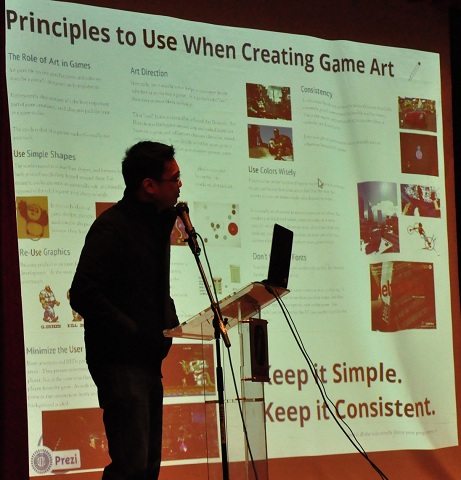ADVERTISEMENT
Filtered by: Scitech
SciTech
Cramming, coding and gaming: Manila Game Jam 2013
By Regina Layug-Rosero

Ryan Sumo, former Chair of IGDA-Manila, talks about Game Art at the orientation for MGJ2013. Photo by Regina Layug-Rosero
How long does it take to make a video game? Blizzard began development on the much-awaited Diablo III in 2001, and beta testing didn’t start until April 2012. While that’s an excessive example, most game development companies will take two to five years to make a massive, complicated game like Gears of War. Even casual games like Angry Birds and Plants vs Zombies take anywhere from a few months to more than a year, from conceptualization to art design, level design and testing, to an actual release. Now, can you imagine cramming all of that activity in 48 hours? Welcome to Manila Game Jam 2013. Manila goes Global The annual Global Game Jam (GGJ) is a worldwide event in which participants gather to develop games simultaneously at various locations. GGJ is organized by the International Game Development Association (IGDA). In 2009, Manila was just one of 53 locations that participated in the very first worldwide event. The Manila Game Jam (MGJ) is organized by the Manila Chapter of the IGDA, currently chaired by Paul Gadi of Inkstone. A game jam is a weekend of nothing but game development. Programmers, artists, musicians, writers and students come together to conceptualize, design and put together games that are ready to be played at the end of the event. It’s a stressful and exciting way to meet new people and learn new things. "It’s the best way to show people that it can be done, that Filipinos have the capability build a video game," said Gadi. How it works The game development process is pretty much the same, whether it’s stretched over three years or crammed into 48 hours. The game dev teams must come up with a concept, figure out game play and level designs, produce art and sounds, code, animate, and test game play. Big game dev studios like EA Games and Blizzard have dozens to hundreds of people working on each part of the process. For smaller companies that work on more casual games, a team will have around 5 to 10 people working on a game. In the game jams, some participants choose to work alone, while others work in small teams or three to five members. Some arrive at the event with their own teams and assignments, while others make friends and form teams on the first day of the jam. But before the actual game development starts, there are a few formalities. First, there is a keynote speech that is broadcast to all the game jam locations simultaneously. It is one of the most awaited elements of the GGJ, because it is in this keynote that the theme for the game jam is announced. The theme is kept secret until this moment. "You can’t really prepare for it," said Gadi. In 2009, the theme was "As long as we have each other, we will never run out of problems." In 2010, it was "Deception" and in 2011 it was "Extinction." For 2012, the theme was the symbol Ouroboros, the snake eating its own tail. Games are expected to work with the theme as best they can. Once the theme is announced, the participants are given time to make a pitch for the game they want to develop. This is usually the point where teams are formed. From here on, there is nothing left to do but work. Participants can stay at the jam sites overnight, or they can choose to go home. Food and drinks are provided by the organizers, as well as some workstations. Internet connectivity is a must at every game jam. Aside from that, participants bring their own tools—code libraries, software, artwork, laptops, cables. As the game jam ends, teams prepare to present their games for test play. "Game-making ends at 3pm on Sunday," said Gadi. "They need to upload it to our site so people can play it, then we will judge them. This year we have trophies for Best Art, Best Game Design. It’s very competitive but it’s always fun." Manila Game Jam 2013 This year, the Global Game Jam was held in 321 sites in 63 countries worldwide, starting on January 25 and ending on January 27. With the event spanning several timezones, the first sites to start jamming were in New Zealand. Hawaii was the last to join in. The Manila Game Jam was held in two sites: iAcademy in Makati, and the De La Salle-College of Saint Benilde in Manila. Each site has its own sets of games and winners. The 2013 keynote speeches were given by Erin Robinson, award winning indie game designer, and Bret Victor, inventor and designer of experimental UI concepts at Apple. At the end of the keynote, the theme was finally announced: a beating heart. It was inevitable that some games would have romantic themes, such as “Now Kiss” and the Donna Cruz-inspired “Kapag Tumibok Ang Puso”. However, a significant number of the teams turned out health-themed games. The winner of the Participants’ Choice Award in iAcademy, for example, was CholesteRUN by the team Kiko Machine, made up of members Kiko Seriña, Jose Luis Araneta and Fred Jacob Soria. The Jury’s Choice award at iAcademy went to Zom-beats by team Dre, composed of members Danilo Africa, Migs Abarintos and Aldrich Siojo. According to the game overview, "In a world where zombies have taken over humanity, humans have learned to blend in within the zombie crowd in order to survive. Unfortunately for humans, a zombie, Dr. Ebe, develops a way to detect the humans among the zombies. Using the device developed by Dr. Ebe you must help the zombies find the humans by using the heart beat detector to detect the humans among the crowd." The rest of the quirky games created during MGJ are online: the games developed at iAcademy and those developed at DLS-CSB. — BM, GMA News
Tags: manilagamejam, mgj2013
More Videos
Most Popular




